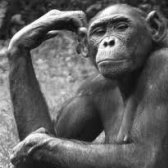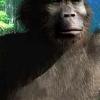@Derek, love ya too brotha and thanks for trusting me to be part of it as I know I can be a devil's advocate pain in the ass sometimes....remember "the good cop, bad cop thang"
@Gigantor, thanks LOL, as one of the jokes here back home in CA is that coming from a fairly prominent local family thanks to my father 's hard work, success & family roots, I could win local office on a stinking Nazi or Radical platform if I wanted..... with one small caveat: Bigfoots must be proven to exist first or I wouldn't have a prayer in hell LOL. Between local articles, all the Rotary, Kiwanis etc.. lectures I've given, the whole town "knows," and my political fate & level of capital is completely tied to "discovery." Believe me, I'm in no hurry.........to run for any office that is I've got two beautiful young children who need me.
@Slim, you know, I've seen some of your written speculation about all of this and I must tell you that you're a very smart & rational person who's very much in the ballpark of truth when it comes to accuracy.
To answer your question, I think my concern was that the sample found could've coincidentally been canid/possible yote due to color similarities and the tapered ends (mentioned previously) immediately identified by Jeff. Logically, if the sample is from the large subject shot, I would assume that it bled out nearby and was consumed by predators...in which I would assume there should be identifying carrion predator DNA through saliva potentially present as well (if that's in fact what happened)
Through his words, it was clearly obvious Meldrum expected or hoped it was going to appear somewhat different, and I think more consistent with primate hair characteristics & the samples in Henner's collection that are considered by many as "the gold standard" because of unique matching characteristics. However, Meldrum did say on tape..... if the DNA is what it is, "then I guess it's a mute point or concern," (that's about the biggest endorsement stated by Meldrum after initial inspection). You make some good points as no one can say for sure and I think Jeff was making observations and sharing what he knows to be, which is considerable with his background (as Bobo was probing for answers from him every few minutes LOL). However, he absolutely left it open and wisely did not make any official or definitive pronouncements without further in depth evaluations off-site.
I would concur Slim that the smell was unique to me as well. Mionczynski, one of this field's biggest assets in my opinion, from a naturalist and forest service experience knowledge base, described it as a "burnt honey" smell that reminded him of one sample he examined a long time ago from WA state I believe.
@exnihilo, I don't know if I'd say I was in the "ape camp" per se as that's kind of become such a cliche & generalization in this field. I would concur with my good friend Matt Pruitt's excellent recent article (http://mattpruittonline.blogspot.com/) as it's very close to the way I feel and he did such a wonderful job of explaining it... it's great to just reference that for others.
Here's some insight from my perspective based on my best personal experiences. The subject I witnessed for almost 3 minutes in the Northern Cascades, WA State in August of 2007 through an X200xp thermal imager from approx 32 yds, had a life changing impact on me to definitively "know" for myself after almost 30 years of interest and passion at that point. I saw that squatch as clear as you can ask for under the circumstances and I'm admittedly discouraged at times that realistically, it's unlikely I'll get an another opportunity like that again even now possessing a handheld thermal unit that has push-button recording ability.
I saw that animal, which was obviously predominantly bipedal, transition much on all fours and get up and down more then once. I'm still amazed at its "animalistic," stealth & agile movements effortlessly executed using body leverage while possessing obvious uneven weight distribution (top to bottom). Anatomical features were also very distinctively different from ours in that it was very top heavy (massive shoulders), lacked a discernible neck & possessed exaggerated arm length. I've also come to realize looking back over the years that much of the behavior I witnessed (again from my perspective & considering it was in pitch black area on waxing moon & under heavy vegetative cover) taught me a lot, including what appeared to be acute hearing sense, potentially average nightvision (failing to appear as if it could lock in on me visually) & undoubtedly.... coordinated movements & behaviors. In other words, I'm absolutely certain the subject "I" witnessed was very different then "us" anatomically & behaviorally.
I'm also influenced by some of the other behaviors I've directly experienced (rock throwing, grunting/ growling, knocking, bluffing behavior etc...) without actually viewing the subject perform it, but through process of elimination, I'm confident was one or more of these animals. One example..... me and my frequent field partner Rgr Leiterman's NorCal coast tree destruction video last year, which was a progressive bluffing behavior going from immediate & initial knock response, and progressing to aggressive tree destruction response (impeccable timing) from continuing external stimulus (my intended provoking & instigative techniques).
These things I've personally experienced coupled with my own viability and inherent behavior research (for them to logically remain collectively unscathed today with a continent-wide distribution) leads me to a species that might be predominantly bipedal, may possess a foot structure similar to ours and even parallel some of us in facial appearance, but I believe still possesses more ape-like physical and behavioral traits.
Here's another thing though that really annoys me (certainly not referencing you exnihilo as I appreciate your question).... people being labeled for their beliefs and often misquoted, are commonly used as name-dropping leverage to strengthen another researcher/enthusiasts arguments who make such a big deal of their own beliefs and theories being correct. How often do we see that?
To be honest, I really can care less what they are and or turn out to be, as my objective has always been to either directly or indirectly, help facilitate discovery. If my theories on biological makeup for instance (which are based on ecology & overall viability) turn out to be completely off base one day, I guarantee you I will still be the happiest person on this earth that the pinnacle of discovery was reached and a lifelong passion has been realized. I certainly don't think I'm alone as I don't want to put words in Meldrum's mouth for example, but do some people really believe that if official scientific recognition happens immediately tomorrow from say, a sudden tragic event like the Sierra kills, that Jeff (myself or anybody else invested in this field to different extents) would be disappointed they shared their best guess within their knowledge base & limited information available and were wrong about many things?
I mean, think about it, if this happens and it turns out bigfoots grow wings & eat plastic, is the most recognized academic associated with the subject going to be sticking his respective head in the sand in shame? I'd confidently contend he wouldn't because he's going to be very busy from now on........and happy.
Bottom line exnihilo, to answer your question and I apologize for some lengthy run-on sentences (bad habit), I'm definitely in the "more ape-like" camp I guess. However, my experiences and beliefs do not influence my actual research, nor compromise my open mind and I could care less if I turn out dead wrong. Just think it's an exhaustive exercise not worth arguing over when we all have a lot more important work to do in the interim in my opinion.


